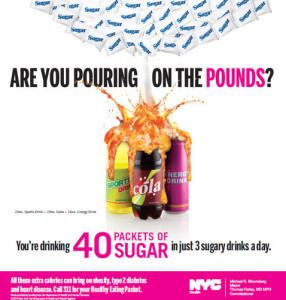NYC: The Big Apple Finds A Way To Keep the Doctor Away
By Khalid Sheikh, MD, MBA // March 8, 2014
drop in 300,000 smokers
ABOVE VIDEO: New York City’s ad campaign, “Pouring On the Pounds” TV spots highlight the risks of drinking too many sugary drinks for both children and adults. Sugary drinks can bring on obesity and diabetes, both of which can lead to serious health problems like heart disease and stroke.
BREVARD COUNTY • VIERA, FLORIDA — Living in New York City (NYC) has some fabulous perks; food, entertainment, nightlife, culture, but a heart healthy lifestyle does not fall high on most people’s lists. However, data presented at last November’s Canadian Cardiovascular Congress in Montreal by New York’s health commissioner indicates that this is very much the case.

Dr. Thomas Farley provided detailed statistics to show that a decade of health policies and health-promotion messages in New York City have pushed heart disease rates downward faster there than they have elsewhere in the U.S.
Since 2002, the life expectancy in New York City has risen by 36 months, compared to an average increase of 21.6 months in the rest of the country.
Over half of this increase is attributable to a lowered risk of fatal cardiovascular diseases.
SMOKING BAN IN PUBLIC PLACES, HIGH CIGARETTE TAXES BOON TO HEART HEALTH
What has transformed New York into a heart-healthy community? The answer lies in a series of public health initiatives.

One of the most important was in 2002, when New York banned smoking in public places and began to tax cigarettes heavily.
Currently New York has the highest cigarette taxes in the country at $6.86 per carton.
In the last decade, the prevalence of smoking in New York has dropped from 21% to 15.5%. This drop in 300,000 smokers has been estimated to have saved 1,500 lives per year. The national prevalence of smoking currently in the U.S. is 19%.
NYC RESTAURANT REGULATIONS FOCUSED ON HEALTHIER DIET
New York has also been pro-active in promoting healthy dietary policies. In 2006, New York began to restrict the trans-fat content of foods in its 24,000 restaurants.

Trans-fat are not natural fats, but are created by food manufacturers when they hydrogenate inexpensive vegetable oils to preserve a food’s shelf life, texture and taste.
Trans-fats are prevalent in many margarines, shortenings and fried and baked products. Not only do trans-fats increased bad cholesterol, but also promote harmful inflammation inside the bloodstream.
In 2008, New York mandated fast food restaurants to post calorie and nutritional information on their menus. This resulted in 15% of consumers reading the information, and those who did so chose meals that were on average 100 calories lower than they previously would have.
Moreover, foods and beverages in vending machines available to New York City employees now must meet nutritional standards of lowered fat, sugar, salt and calorie content.
AGGRESSIVE DIETARY EDUCATION TARGETS ADDED SUGAR, SALT AND FAT INTAKE
Like most of the country, nearly 60% of New Yorkers are obese or overweight. New York has actively engaged in public information campaigns to encourage consumption of fruits and vegetables, and discourage sugar, salt and fat intake.
 New York started the National Salt Reduction Initiative. Embraced now by 90 cities and states, the initiative has a goal of reducing salt intake in communities by 25%.
New York started the National Salt Reduction Initiative. Embraced now by 90 cities and states, the initiative has a goal of reducing salt intake in communities by 25%.
As a result, last year, 21 companies met voluntary sodium-reduction targets for such products as Heinz ketchup (15% lower) and Kraft singles American cheese (18% lower).
New York has also put forth an initiative to restrict access to supersize sugary drinks. Sugary drinks are a key source of calories. A two liter size of Coca Cola contains the equivalent of 50 packets of sugar and 800 calories. This initiative is still being challenged in the courts.
However, in response, the New York department of health designed an ad campaign with the slogan “Are you pouring on the pounds?” Even consumption of diet drinks has been associated with obesity, as it is often associated with other unhealthy dietary habits. Just the awareness created by such initiatives has already resulted in a small but measurable drop in childhood obesity.
FUTURE NYC PUBLIC WELLNESS CAMPAIGNS TO FOCUS ON EXERCISE
One area that New Yorkers still lag behind in is exercise. However, New Yorkers maintain fitness because they walk more, use stairs more and ride the subway more than they use cars.

New York has the greatest proportion of area devoted to green spaces and playgrounds than any other city of comparable size. The next focus of New York’s public wellness campaigns will be in encouraging exercise and physical activity.
The model of public health initiatives by communities to improve heart wellness is relatively new. Traditionally, heart-health has been promoted on an individual level by physicians counseling patients.
However, the success rates of modifying unhealthy behaviors in such individual interactions remain relatively low. This is due to many factors, including patient motivation and the time and commitment of the counseling physician in promoting patient education.
MIND OVER MUNCH
Changing the focus to public health initiatives for improving community wellness is not without precedent. A hundred years ago small pox, cholera and yellow fever were not eradicated by encouraging individuals to wash their hands. Instead, communities installed safe water and sewage systems and mandated vaccinations.

I have a vested interest in New Yorkers being healthy. My oldest daughter lives and works in New York City. She has some great and fun information in her health and fitness website, Instagram posts and YouTube channel.
You can find all of these on Mind Over Munch.
To learn more about prevention, treatment and reversal of heart disease, get the book Don’t Let Your Heart Attack!, available on Amazon, Barnes & Noble and iTunes.
ABOUT THE AUTHOR

Dr. Sheikh, a member of Health First Medical Group, directs a cardiology practice specializing in lipid management and cardiovascular disease prevention, treatment and reversal in Cocoa Beach, Florida. He was a Professor of Cardiology at Duke University before entering private practice, and is currently on the clinical faculty at the University of Central Florida College Of Medicine. Dr. Sheikh, who was recognized by the Consumers’ Research Council of America as one of America’s Top Cardiologists, is board certified in both Internal Medicine and Cardiovascular Diseases, and is a Fellow of the American College of Cardiology. He is also a certified clinical lipid specialist, board certified in












